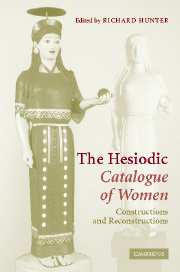Book contents
- Frontmatter
- Contents
- Notes on contributors
- Acknowledgements
- List of abbreviations
- Introduction
- 1 Ordering women in Hesiod's Catalogue
- 2 The beginning and end of the Catalogue of Women and its relation to Hesiod
- 3 Gods among men? The social and political dynamics of the Hesiodic Catalogue of Women
- 4 Heracles in the Hesiodic Catalogue of Women
- 5 Mestra at Athens: Hesiod fr. 43 and the poetics of panhellenism
- 6 A catalogue within a catalogue: Helen's suitors in the Hesiodic Catalogue of Women (frr. 196–204)
- 7 Pulp epic: the Catalogue and the Shield
- 8 The Megalai Ehoiai: a survey of the fragments
- 9 Ordered from the Catalogue: Pindar, Bacchylides, and Hesiodic genealogical poetry
- 10 The Hesiodic Catalogue and Hellenistic poetry
- 11 From genealogy to Catalogue: the Hellenistic adaptation of the Hesiodic catalogue form
- 12 The Hesiodic Catalogue of Women and Latin poetry
- 13 Or such as Ovid's Metamorphoses …
- Bibliography
- Index of passages discussed
- General index
Introduction
Published online by Cambridge University Press: 22 September 2009
- Frontmatter
- Contents
- Notes on contributors
- Acknowledgements
- List of abbreviations
- Introduction
- 1 Ordering women in Hesiod's Catalogue
- 2 The beginning and end of the Catalogue of Women and its relation to Hesiod
- 3 Gods among men? The social and political dynamics of the Hesiodic Catalogue of Women
- 4 Heracles in the Hesiodic Catalogue of Women
- 5 Mestra at Athens: Hesiod fr. 43 and the poetics of panhellenism
- 6 A catalogue within a catalogue: Helen's suitors in the Hesiodic Catalogue of Women (frr. 196–204)
- 7 Pulp epic: the Catalogue and the Shield
- 8 The Megalai Ehoiai: a survey of the fragments
- 9 Ordered from the Catalogue: Pindar, Bacchylides, and Hesiodic genealogical poetry
- 10 The Hesiodic Catalogue and Hellenistic poetry
- 11 From genealogy to Catalogue: the Hellenistic adaptation of the Hesiodic catalogue form
- 12 The Hesiodic Catalogue of Women and Latin poetry
- 13 Or such as Ovid's Metamorphoses …
- Bibliography
- Index of passages discussed
- General index
Summary
The Catalogue of Women ascribed to Hesiod is one of those (many) ancient poems where enough survives to intrigue and to allow the formulation of very interesting questions, but not enough to answer any more than a few of them. The essays in this book reveal the pleasure and the frustration in almost equal measure. Unanimity is not to be expected.
The Catalogue was a poem of ambitious scope and length (Hellenistic scholars divided it into five books) which constructed a map of the Hellenic world in genealogical terms; the organising principle within the great families was the offspring of mortal women and gods, and some of these women were introduced by the ἠ᾿ οἵη ‘or such as’ formula which gave the poem its other title, Ἠοῖαι. The Catalogue was clearly thought of as a continuation of the Theogony (the final part of which has suffered in transmission and contains some relatively late material), and appears to have been transmitted as part of this latter poem until they were separated, perhaps through a mixture of scholarly acumen and the demands of the book trade; the identification of the Catalogue as a separate poem seems to have occurred at least by the high period of Alexandrian scholarship, although Theogony and Catalogue may have continued to be treated as parts of a single work in some texts.
- Type
- Chapter
- Information
- The Hesiodic Catalogue of WomenConstructions and Reconstructions, pp. 1 - 4Publisher: Cambridge University PressPrint publication year: 2005

